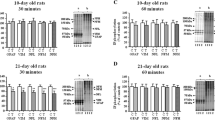Abstract
Rats were made hyperammonemic by feeding them a diet containing ammonium acetate. The tubulin content in their brain increased ≥30% after 20 days on the diet. All the increase was found in polymerized tubulin; no increase in free tubulin was noted. When rats on the ammonium diet were then fed the standard diet, the tubulin increased slightly on the first day but decreased markedly on the second day, reaching control values on the third day. It should be noted that brain tubulin synthesis, was not reduced on the first day of feeding the standard diet but was markedly inhibited (to ≈40% of control) on the second day, returning to control values on the third day. On the first day of refeeding there is a remarkable disassembly of microtubules with a large, proportional increase (≈50%) of free tubulin. Both free and polymerized tubulin levels returned to control values on the third day. These results indicate that in hyperammonemia changes in the degree of polymerization of tubulin preceded those in tubulin synthesis.
Similar content being viewed by others
References
Azorín, I., Miñana, M. D., Felipo, V., and Grisolía, S. 1989. A simple animal model of hyperammonemia. Hepatology 10:311–314.
Felipo, V., Miñana, M. D., and Grisolía, V. 1988. Long-term ingestion of ammonium increases, acetylglutamate and urea levels without affecting the amount of carbamoyl-phosphate synthase. Eur. J. Biochem. 176:567–571.
Felipo, V., Miñana, M. D., and Grisolía, S. 1988. Induction of rat brain tubulin following ammonium ingestion. J. Neurochem. 51:1041–1045.
Miñana, M. D., Felipo, V., Wallace, R., and Grisolía, S. (1988). High ammonia levels in brain induce tubulin in cerebrum but not in cerebellum. J. Neurochem. 51:1839–1842.
Miñana, M. D., Felipo, V., Quel, A., Pallardó, F., and Grisolía, S. 1989. Selective regional distribution of tubulin induced in cerebrum by hyperammonemia. Neurochem. Res. 14:1241–1243.
Ben-Ze'ev, A., Farmer, S., and Penman, S. 1978. Mechanisms of regulating tubulin synthesis in cultured mammalian cells. Cell 17:319–325.
Felipo, V., Portolés, M., Miñana, M. D. and Grisolía, S. (1986). Rats that consume caffeine show decreased brain protein synthesis. Neurochem. Res. 11:63–69.
Beltramo, D. M., Arce, C. A. and Barra, H. S. 1987. Tyrosination of microtubules and non-assembled tubulin in brain slices. Eur. J. Biochem. 167:136–141.
Caron, J. M., Jones, A. L., Rall, L. B. and Kirschner, M. W. 1985. Autoregulation of tubulin synthesis in enucleated cells. Nature 317:648–651.
Gay, D. A., Sisodia, S. S., and Cleveland, D. W. 1989. Autoregulatory control of β-tubulin mRNA stability is linked to translational elongation. Proc. Natl. Acad. Sci. USA 86:5763–5767.
Cleveland, D. W. 1988. Autoregulated instability of tubulin mRNAs: a novel eukaryotic regulatory mechanism. TIBS 13:339–343.
Author information
Authors and Affiliations
Rights and permissions
About this article
Cite this article
Felipo, V., Miñana, MD. & Grisolía, S. Hyperammonemia induces polymerization of brain tubulin. Neurochem Res 15, 945–948 (1990). https://doi.org/10.1007/BF00965917
Accepted:
Issue Date:
DOI: https://doi.org/10.1007/BF00965917




